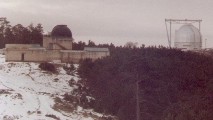
| 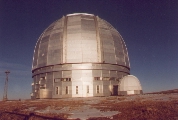 |
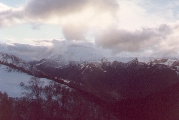
| 
|
This is the famous Soviet (now Russian) 6-meter telescope, in operation since 1976. The first really large optical telescope to incorporate an altazimuth mount (and thus requiring constant computer control to operate), it is located on the slopes of Mount Pastukhov on the northern side of the Caucasus range, between the Black and Caspian Seas. The telescope uses an f/4 primary mirror (giving a 26-meter tube housed in a dome 58 meters high), with instruments located in an expansive prime-focus housing or at one of the Nasmyth foci on either side of the fork mount (one of the spectrographs has a collimator 2 meters across).

|  |

| 
|
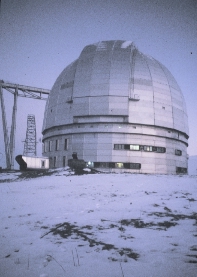 I got a chance to try the BTA
first-hand in 1990, using a multifiber array designed by
Viktor Afanasiev and coworkers to map the kinematics of interacting galaxies.
The twilight picture of the dome shows the construction crane, left
in place since there was no pressing reason to remove it, a construction jig
used for the dome segments, and the
entrance tunnel for the front door, to maintain access even during severe
winters.
The need for field rotation means that one must simultaneously track two
guide stars on opposite sides of the field center to keep both the field
position and orientation constant, for which a mirror arrangement feeds opposite
sides of the guiding TV camera. At the rate at which the Keck I telescope was
adding mirror segments
at this time, I just barely managed to be using the largest optical telescope
on Earth. Maybe one of these days I'll be able to repeat
such a performance... Anyway, the fiber array generated sets of spectra,
partially blended but separable because of slightly different wavelength
coverage. Data reduction starts from such a frame, extracts each individual
spectrum, and then goes on to produce maps of line intensity, velocity or
ionization, as seen in
sample data shown below for the starburst wind of NGC 2782. A direct image
can be taken with the lenslet array outline superimposed on the object,
to verify how the data are registered on the sky (each rectangle
shows a 2x2 set of apertures). Results from my
observing run appeared in several papers -
one on the spin properties of spirals in pairs,
one on how these couple to star formation,
mapping the starburst wind in NGC 2782,
an exploration of the hyperbolic flyby in NGC 4438,
and the bizarre multiple emission-line systems in Karachentsev 29S.
I got a chance to try the BTA
first-hand in 1990, using a multifiber array designed by
Viktor Afanasiev and coworkers to map the kinematics of interacting galaxies.
The twilight picture of the dome shows the construction crane, left
in place since there was no pressing reason to remove it, a construction jig
used for the dome segments, and the
entrance tunnel for the front door, to maintain access even during severe
winters.
The need for field rotation means that one must simultaneously track two
guide stars on opposite sides of the field center to keep both the field
position and orientation constant, for which a mirror arrangement feeds opposite
sides of the guiding TV camera. At the rate at which the Keck I telescope was
adding mirror segments
at this time, I just barely managed to be using the largest optical telescope
on Earth. Maybe one of these days I'll be able to repeat
such a performance... Anyway, the fiber array generated sets of spectra,
partially blended but separable because of slightly different wavelength
coverage. Data reduction starts from such a frame, extracts each individual
spectrum, and then goes on to produce maps of line intensity, velocity or
ionization, as seen in
sample data shown below for the starburst wind of NGC 2782. A direct image
can be taken with the lenslet array outline superimposed on the object,
to verify how the data are registered on the sky (each rectangle
shows a 2x2 set of apertures). Results from my
observing run appeared in several papers -
one on the spin properties of spirals in pairs,
one on how these couple to star formation,
mapping the starburst wind in NGC 2782,
an exploration of the hyperbolic flyby in NGC 4438,
and the bizarre multiple emission-line systems in Karachentsev 29S.
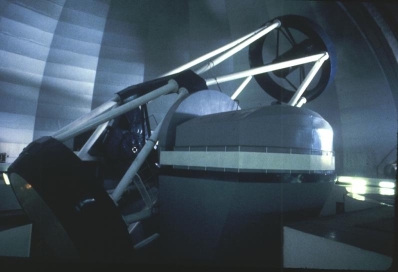
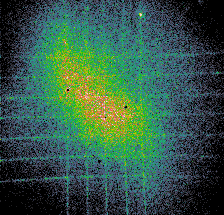
| 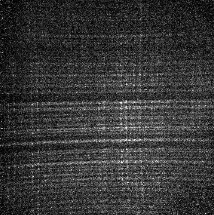
|
The experience of observing with the BTA was described in the following article I did for Sky and Telescope (text copyright Sky Publishing Corporation 1992, reproduced here by permission). The interspersed pictures here are not necessarily the ones originally accompanying the article.
A table of the world's largest optical telescopes would include names familiar to practicing observers and armchair enthusiasts alike: Palomar, Kitt Peak, Cerro Tololo, and their kin. However, for 15 years the list has been topped by an enigma - the 6-meter reflector of the former Soviet Union.
Few results from this huge instrument have appeared in Western literature, and rumors persist that attribute this dearth to the facility's poor optical quality, instrumentation, and observing conditions. While foreigners occasionally are given time on the 6-meter, very few U. S. astronomers have actually used it. In fact, there is relatively little firsthand information in the West on its capabilities.
The possibility of my using the 6-meter telescope opened up in late 1989 during conversations in Alabama with members of its staff, who work for the Special Astrophysical Observatory (SAO) of the Soviet -- now Russian -- Academy of Sciences.
Like many optical observers, I have traveled far and wide in search of photons. I have used telescopes at Kitt Peak and Lowell observatories to investigate interacting galaxies in particular, trying to learn how the internal motions during such collisions trigger star formation and nuclear activity.
SAO astronomer Igor Karachentsev, a member of the time- allocation committee for the 6-meter telescope, suggested that it would be well suited for spectroscopy of such objects. I hurriedly sketched out an observing proposal before he returned home. Several months later, I was surprised to receive a telegram informing me that my program was allocated three nights on the telescope in December, 1990.
The 6-meter telescope is listed under various names in English-language publications. Some references link it to the village of Zelenchukskaya 40 kilometers to its north, after the nearby Zelenchuk River, or after Mount Pastukhov, where the telescope is sited. But officially it is the Bolshoi Teleskop Azimutal'ny ("Large Altazimuth Telescope"), or simply BTA. Conceived in the mid-1960's, the BTA went into operation in 1976.
The telescope is situated at an altitude of 2,070 meters (6,800 feet) on the northern slopes of the Caucasus Mountains. It lies about 150 km south of Stavropol between the Black and Caspian seas, within Russia but very near the boundary with Georgia. The observatory staff and their families live close by in the small scientific enclave of Nizhny Arkhyz, in the valley of the Greater Zelenchuk River. Some of the locals call the village Bukovo, after the beech (buk) trees that populate the forest. About 1,000 persons live in its four high-rise apartment buildings. The location is isolated enough that the town must have its own schools, shops, post office, and power plant. Machine shops, computing facilities, and photographic labs are also here.
The observatory is usually reached through the resort and spa town of Mineralniye Vody ("mineral waters"), to which there are daily flights from Moscow and rail connections. It takes most of a day to reach Nizhny Arkhyz by public transit, but only three hours using the observatory van -- a privilege accorded Western visitors. The road winds through both glum industrial towns and picturesque countryside. About 20 km outside of Zelenchukskaya the road actually rims the sprawling RATAN-600 radio telescope. This ring antenna, 600 meters in diameter, is aimed by angling its individual panels toward a central receiver.
Just as at Kitt Peak or the European Southern Observatory, the presence of a large facility provides a useful site for smaller telescopes run by other institutions. Kazan University (about 1,000 km east of Moscow) maintains an observing station on Mount Pastukhov. It consists of a small astrograph for student projects, a 61-cm reflector for occultations and photometry, and a large new horizontal telescope for work on lunar motion and coordinate systems.
Practically in the shadow of the BTA is a 1-meter Zeiss Jena reflector, which recently completed a year of shakedown operations. According to Vladimir Romanenko, who was responsible for some of these tests, the telescope is used for direct photography and a program to measure stellar magnetic fields using polarimetry. A coude spectrograph should be completed sometime this year.
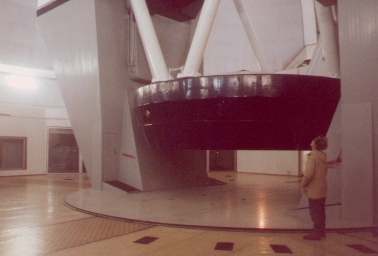 The BTA itself is an altazimuth reflector whose Ritchey-
Chretien optics have a primary focal ratio of f/4.
Instruments ride either in a large prime-focus cabin or on
one of the two Nasmyth platforms that top the azimuth fork.
The telescope's designers felt there was little need for a
Cassegrain focus, as the image scale at prime focus (8.6 arc
seconds per millimeter) is comparable to that found at the
Cassegrain or Ritchey-Chretien focuses of most 4-meter
telescopes. Eliminating a Cassegrain focus allowed a very
clean design, and the primary's cell swings quite close to
the observing floor. Cables to the prime-focus cage are not
apparent externally, so the telescope retains an uncluttered
appearance. This probably contributes to the impression
that it doesn't really look as big as it is.
The BTA itself is an altazimuth reflector whose Ritchey-
Chretien optics have a primary focal ratio of f/4.
Instruments ride either in a large prime-focus cabin or on
one of the two Nasmyth platforms that top the azimuth fork.
The telescope's designers felt there was little need for a
Cassegrain focus, as the image scale at prime focus (8.6 arc
seconds per millimeter) is comparable to that found at the
Cassegrain or Ritchey-Chretien focuses of most 4-meter
telescopes. Eliminating a Cassegrain focus allowed a very
clean design, and the primary's cell swings quite close to
the observing floor. Cables to the prime-focus cage are not
apparent externally, so the telescope retains an uncluttered
appearance. This probably contributes to the impression
that it doesn't really look as big as it is.
The massive altazimuth mount -- the first for a large
optical telescope -- points, tracks, and compensates for
field rotation well. The real problems, ironically, stem
from the conservative
Low- and high-dispersion spectrographs are located on the two Nasmyth platforms, which are reached by elevators running through the bottom of the vertical fork mounting. For the latter spectrograph, the collimator mirror alone is 2 meters across! The Nasmyth foci are fed by a rotatable tertiary mirror located along the elevation axis of the telescope mount, so that each focal point is fixed (but rotates) with respect to the spectrographs. The SAO staff makes the best use of the available observing time by rapidly switching between prime-focus and Nasmyth instruments; thus single-object spectroscopy can be substituted when the seeing or sky transparency is too poor for prime-focus work on faint objects.
A telescope is only as good as its instruments, and the BTA is only now getting the kinds of modern digital detectors that can make it competitive with other large telescopes. At the prime focus, spectroscopy can be done either with a long slit or a mapping array of optical fibers. These are normally done with a photon-counting system, though recently charge-coupled devices (CCD's) have become available. Imaging, using either direct photography or CCD's, is also done at the prime focus. Since the prime focus offers a wide field, future plans include upgrading the CCD's and greater use of multiobject instruments.
Large altazimuth telescopes can function only under constant computer control. The ones running the BTA and its instruments, while adequate to the task, are comparable to those found at Kitt Peak or Lick a decade ago. But faster, more capable PC's handle the data reduction and analysis. Fortunately, these are no longer under export control, and I saw models made in a variety of countries. But finding the money to purchase computers, tapes, and disks is difficult.
SAO director Viktor Afanasiev and his research group gave me the option of observing with a long-slit spectrograph at the prime focus or with a fiber-array spectrograph that could map all parts of a 10-by-15-arc-second area at once. Some of the objects on my program clearly have complicated dynamics, so I quickly opted for the fiber array. But my choice required extra preparation, since there are unique problems in aiming blind to such a small area.
Perhaps not coincidentally, Afanasiev's group would be observing on three nights adjacent to mine. Since some of them would have to be on the mountain to support the instrument I would use, we agreed to share all six nights and split any clear ones. This was a welcome compromise, since it spread out the risk of bad weather. Afanasiev and his collaborators have begun a large program to map the emission lines from the nuclei of Seyfert galaxies, as a probe of gas flow along small bars around the nuclei.
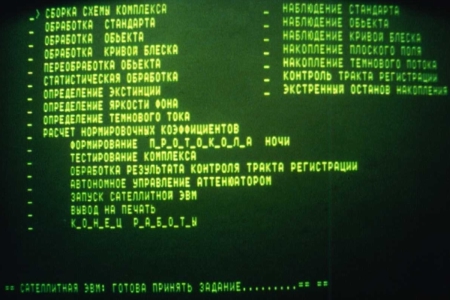 The actual observing experience is similar to that at most
large telescopes -- the observer watches monitors in an
enclosed control room. There is a direct video image of the
field under study, and all manual guiding is based on this
display. That's as close as I came to actually running the
telescope. Given the rapidly changeable local weather,
observers often stick their heads out windows to check for
clouds. But glimpsing the whole sky at once requires
rousing the watchman to unlock the front door - something
not done frivolously in the wee hours of the morning.
The actual observing experience is similar to that at most
large telescopes -- the observer watches monitors in an
enclosed control room. There is a direct video image of the
field under study, and all manual guiding is based on this
display. That's as close as I came to actually running the
telescope. Given the rapidly changeable local weather,
observers often stick their heads out windows to check for
clouds. But glimpsing the whole sky at once requires
rousing the watchman to unlock the front door - something
not done frivolously in the wee hours of the morning.
By the run's second night I had obtained some fiber-array spectra, relieving my fear of returning home empty-handed. The setup for each object can take as long as 30 minutes, using the stars visible in small offset fields to locate the galaxy of interest, rotating the spectrograph if a particular orientation on the sky is needed, taking an image of the target through the spectrograph optics to verify the relative positions of the fiber apertures, and taking sets of wavelength-calibration exposures. All this provides a strong incentive to use long exposures once everything is set up.
During much of the observing run, we played tag with clouds and wind. Despite the telescope's immense mass (840 tons!) pointing into a strong wind introduces unacceptable shaking. When the strong prevailing winds blow in from the Caucasus range to the south, observations are restricted to declinations north of +42 degrees. This is especially frustrating in winter, when most galaxies lie south of the Milky Way. At one point in our blustery run, SAO astronomer Alla Shapovalova invoked international relations to keep the operator from closing the dome. "You mean you want Bill to go back to America with no data?" she prodded.
Aside from getting the observations themselves, I found this visit to have special value in getting a look at a different astronomical community. Optical astronomy is making steady if slow progress in Russia despite the inhibiting conditions under which this work is done. Some valuable survey work has involved various types of galaxies. Now under way is a complete spectroscopic survey of faint stars and galaxies in selected areas of the sky, using a newly acquired CCD manufactured in St. Petersburg. Afanasiev has designed a new spectrograph that should offer much higher quantum efficiency than the off-the-shelf Zeiss Jena equipment now in use.
But if the telescope does indeed "work," why haven't we heard more from it? Certainly there have been longstanding problems in getting modern detectors for the BTA, which are only now being remedied. The lack of widely known results, though, owes almost as much to other factors. Some of this work was published originally in English to attract wider attention, but in a style sufficiently different from ours that they went largely unnoticed. The results do appear in the Russian-language journals Astrofizika and Astronomicheskii Zhurnal, but these aren't always available in translation, and few libraries subscribe to all of the relevant series.
Furthermore, Western authors usually provide fuller details of the observations and their quality than their Russian colleagues do, which has led to suspicions that lack of information is a cover-up for poor data. Early on, one often heard anecdotes of marginal BTA data that had been overinterpreted. However, such cases should be a thing of the past now that digital detectors are in regular use.
Finally, the scientific emphases of our differing astronomical communities can give the impression that research not in vogue at a certain time is vaguely irrelevant. Since communication with the Commonwealth republics is now more open, perhaps we can look forward to a richer and more unified approach to astronomy.
However, my Russian colleagues face an uphill battle. After
the dissolution of the Soviet Union, the Academy of Sciences
fell under Russian control after a brief but intense debate.
These days getting the "hard" (convertible) currency from
the Academy to buy anything Western -- even professional
journals -- is next to impossible. Those on the SAO
professional staff tell me their jobs are secure for
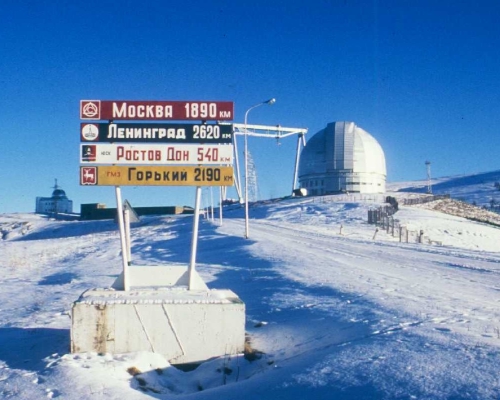 After the 6-meter telescope's completion in the mid-1970's,
rumors began circulating almost immediately about the sorry
state of its optics and the chronically poor atmospheric
seeing that enveloped the observatory. In fact, the saga of
the BTA even made it into James Oberg's 1988 book Uncovering
Soviet Disasters.
After the 6-meter telescope's completion in the mid-1970's,
rumors began circulating almost immediately about the sorry
state of its optics and the chronically poor atmospheric
seeing that enveloped the observatory. In fact, the saga of
the BTA even made it into James Oberg's 1988 book Uncovering
Soviet Disasters.
The original mirror indeed had significant imperfections - including cracks covered with black cloth - attributed to the Russians' inexperience with such large optics. According to Bagrat K. Ioannisiani, the telescope's chief designer, the flawed Pyrex primary directed 61 percent of the incoming light into a 0.5-arc-second circle and 91 percent into one with twice the diameter. A second Pyrex mirror, with an improved figure and no cracks, was installed in 1978. SAO astronomers have struggled for years to replace it with one of low-expansion Sitall glass, and at last word they expect it to be ready this year.
Thermal effects are so significant in the 42-ton primary that it can tolerate only a 2-degree Celsius change per day and still retain a usable figure. If the temperatures of the primary and the outside air differ by even 10 degrees, observations become impossible. This touchy situation has been ameliorated somewhat by the installation of round-the-clock refrigeration inside the dome. On the rare occasions when both atmospheric turbulence and temperature variations are small, the telescope has delivered images of 1 arc second or better.
The BTA does not enjoy a site comparable to those in Arizona or California, much less La Palma or Mauna Kea. It is often in the turbulent downwind wake of nearby peaks higher up in the Caucasus range. This degrades the seeing and introduces pointing restrictions when the wind exceeds about 45 km per hour. The geography makes for rather unstable local weather, with strong year-to-year fluctuations. Usable nights per month can range from none to 20 - even for the same month in different years. On average observing takes place on fewer than half of the nights throughout the year.
Ironically, better sites within the Soviet Union had been identified during 16 expeditions conducted around 1960. But most of these are in Central Asia, locations so remote that the logistical problems of constructing such a major facility would have been formidable. Nevertheless, the site finally chosen is quite dark, and one can see the snow-capped Caucasus peaks by starlight and outlined by the Milky Way.
Aside from the poor seeing present at the site itself, Russian astronomers admit that the 6-meter's dome itself degrades image quality significantly. Forty-seven meters high, it is big enough for a 15- to 25-meter short-focus instrument. In fact, SAO astronomers note with chagrin that the telescope clears the dome's ceiling by 12 meters! Given this oversize cocoon of metal, with its considerable thermal inertia, it's little wonder that 2-arc-second images are classed as good seeing. One internal SAO report states that observers can count on 1.5-arc-second images only 10 percent of the time. This compares poorly with sites like Mauna Kea, whose telescopes routinely perform at half that value.
Still to come: NGC 2782 data from slitlet array
The following may also be of interest. This is taken from a tourist brochure distributed at the BTA site, circa 1978. The translation, and thus all attendant foulups, are mine.
Astronomy is a national science. Beginning in the 17h century, it started as a practical one, when astronomy grappled with problems of navigation. The second half of the 19th and early 20th centuries saw a period of enormous cosmic discovery and enormous progress in the basic sciences. In recent decades, all the major governments have begun to provide great resources for astronomy, invested in large telescopes and observatories. Many physicists and mathematicians apply their talents to the observations of physical properties of cosmic space. Only in the Universe, the ultimate laboratory, is it possible to observe the most powerful physical processes, employing fantastic energies impossible to replicate on a terrestrial scale. Many of these observed processes are still inexplicable to contemporary physics. And still, one knows that sooner or later these will be brought to practical application.
The pace of astronomy, as in any other field of science driven primarily by experiment, requires powerful telescopes, the newest light detectors, measurement and computing technologies. These requirements led the USSR Academy of Sciences to decide upon the construction of a 6-meter optical telescope (BTA), the world's largest, and a 600-meter radio telescope (RATAN-600), and upon these foundations, the Special Astrophysical Observatory of the USSR Academy of Sciences. So remarkable was the work of chief designer Lenin prize holder B.K. Ioannisian - the 6-meter primary mirror - that his ideas foresaw present capabilities, based upon current possibilities and determining the size of the telescope. Work on the giant telescope and observatory was begun in 1959 at the Main Astronomical Observatory at Pulkovo. To select the site for its installation, 16 expeditions were dispatched to various regions of the USSR. The construction and equipping of the telescope were assigned to the Leningrad Optical-Mechanical Works (LOMO) and other specialized organizations. The basic feature of the telescope - the parabolic mirror - was settled during these preparations as well.
As a result of extensive selection, the decision was made to locate the 6-meter telescope in the North Caucasus mountains near Zelenchukskaya at a height of 2100 meters above sea level. This region is distinguished by good seeing, high atmospheric transparency, and a sufficient number of clear nights. This region also appeared satisfactory for the RATAN-600. No small role was played by the consideration that the region selected should have sufficient industrial potential for construction of the observatory and both normal and further functions. (complicated statement about sufficiency of local economy and support skipped)
The Special Astrophysical Observatory (SAO) was established along the lines of a scientific research institute by the Presidium of the USSR Academy of Sciences on 3 June 1966. The original director was Doctor of Physical- Mathematical Sciences I.M. Kopylev.
The first images were obtained with the BTA on 28 and 29 December 1975. Thus was fulfilled a 15-year task of many collectives within the USSR. In January 1977 the 6-meter telescope went into regular scientific observations.
The BTA is a general astronomical instrument, equipped to address the resolution of long-standing astrophysical puzzles. A mirror of this area collects sufficient light to allow observations of faint and distant objects in the Universe. The BTA is installed in a building of diameter 48 meters and height 45 meters, of which the rotating dome weighs 1000 tons.
An outstanding characteristic of the BTA is its altazimuth mounting (as on a theodolite), allowing it to point at any desired area of the sky, pivoting about vertical and horizontal axes. Up to this time optical telescopes have primarily used equatorial mountings, in which one of the axes of the telescope was in the direction of the Earth's pole, parallel to the axis of Earth's rotation. An altazimuth mounting allows the existence of improved telescopes, making them more compact. Nevertheless the moving weight of the telscope is 650 tons, of the mirror alone 42 tones, and of the mirror with its support system 80 tons. Using the telescope to study of objects which appear to move because of the Earth's rotation requires electric motors and the help of specialized electronic computers. It is necessary to have a complex system connected with the motions of stars across the sky with respect to one another. Therefore the motions of the telescope about horizontal and vertical axes proceed at varying rates, controlled at every instant by the calculating equipment. The error in motion cannot exceed one second of arc per second of time. Despite the great accuracy of the mechanical work, the telescope departs from the ideal due to such factors as mechanical flexure, temperature variations, wind loading, etc. Therefore a "photo-guiding" system is used to correct the motion of the telescope using the stars themselves.
The BTA is equipped with a variety of light-sensitive apparatus, allowing the intensification of weak light and its analysis for the physical properties of celestial objects. The apparatus may be installed at four locations - the prime focus, on both platforms, and within one of the mounting pillars. At the prime focus (24 meters) an observing cabin is installed, within which are set detectors. The platforms hold spectrographs along horizontal axes for spectra of stars and other objects. One carries the Basic stellar spectrograph, one of whose optical elements has a 2-meter diameter (as in the mirror of a fairly large telescope). The light to each platform is folded by a diagonal mirror.
Last changes: 2/2000 © 1999,2000